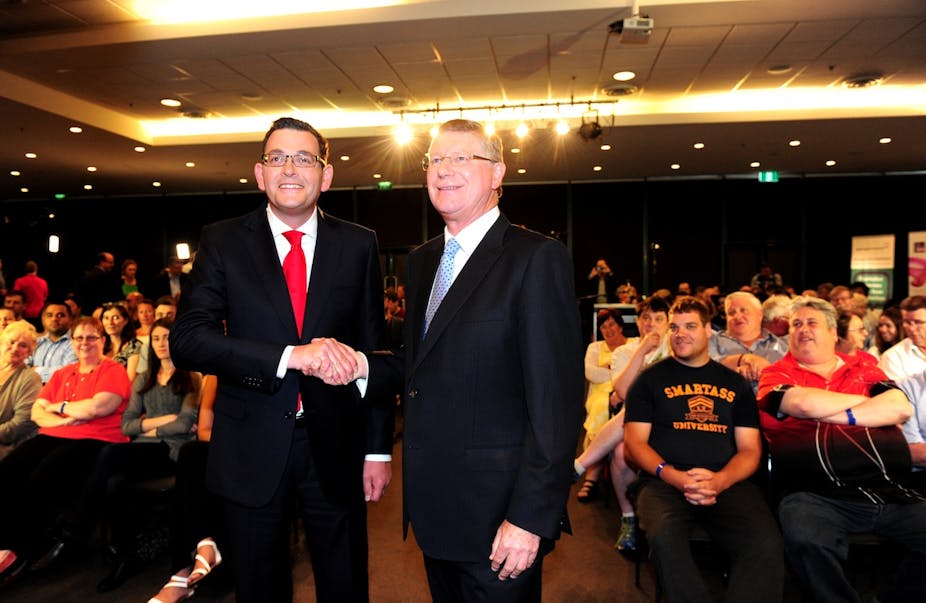Victorian voters go to the polls this weekend having been bombarded with myriad spending promises from the Coalition and Labor.
Major promises from the Coalition government include:
- $3.9 billion for 75 new trains, 75 new trams and 24 new V/Line regional rail cars
- An airport rail link - costed at up to $11 billion
- $367.8 million over five years for policing
- $100 million regional cities fund
- $250 million on CityLink and road widening (includes $200m from the federal government)
- $178.1 million to improve V/Line rail frequency
- $150 million to prevent family violence
- $78 million over four years to put primary welfare officers in every state school
- $77.5 million for the Andrew Love Cancer Centre in Geelong
- $75 million to help long-term unemployed youth, offering a $2,000 voucher to employers who take them on
- $70 million towards a $120 million heart hospital at Monash Medical Centre
- $61 million for rural hospital capital works
- $23 million over four years for a $100 rebate for every family with a child in kindergarten (not means-tested).
And from Labor:
- $1.3 billion education and skills package, including $320 million TAFE rescue fund
- $1 billion for suburban roads
- $800-$900 million on 30 new Metro trains and 20 V/Line rail cars
- $510 million for government schools
- $500 million regional jobs and infrastructure fund for Ballarat
- Up to $300 million for a Victorian Heart Hospital
- $200 million for a women’s and children’s hospital in Sunshine
- $200 million “Beds Rescue Fund”
- $100 million to remove asbestos from schools
- $100 million to improve ambulance services/facilities
- $100 million to improve bus networks
- $100 million over six years creating a network of paths for cyclists and pedestrians.
Peter Martin and Sian Johnson estimate that the Labor spending is highly biased towards the marginal seats. Promised spending in these seats exceeds five times that promised by the Coalition. A cynical person would comment here about elections being more about buying votes than good policy.
The election promises of both sides have concentrated on big spending. There is little mention of any new taxes or charges or what cuts should be made elsewhere to pay for this spending.
In election campaigning, proposing tax increases is a definite no-no politically, although responsible government may demand it and fairly straightforward options are available to state governments. For instance, it is well known in economics that a payroll tax is virtually equivalent to a broad-based consumption tax (such as the GST). This relatively efficient and cheap way of raising revenue for the states may be economically sensible but is anathema to politicians, thanks to the widely held, but misguided, view that it is a “tax on jobs”.
Attention has mostly focused on budget deficits and accumulating debt at the Commonwealth level. However, more than 40% of total government debt is attributable to state and local governments.
While Victoria is in better shape than most other states, particularly Western Australia, budget deficits and accumulating debt are still a fundamental problem. The state has been running deficits for almost 10 years. Victoria’s current deficit (as a percentage of total revenue) is estimated to be around 9%, a significant reduction on the previous financial year.

The estimated deficit and return to balance (or surplus) depend, of course, on the assumptions on which they are based. One of these, importantly, is that the Australian economy doesn’t suffer any nasty shocks. This is quite a bold assumption since the international economy, particularly Europe, is still fragile, with another global crisis quite possible. China is not looking as stable as it has been, with slower (but still high) growth and asset bubbles looming.
The impact of car industry closures may be greater than expected, particularly for Victoria and South Australia. There is concern about a bursting of the “housing bubble”, particularly in Melbourne and Sydney, with consequent falls in revenue from property taxes. Perhaps most serious is the inability of the Abbott government to get many of its budget measures through the Senate, leaving an almost A$50 billion hole in the budget.
In the longer term, a new report by the Parliamentary Budget Office demonstrates the Commonwealth’s estimates of budget surpluses/deficits are highly sensitive to key assumptions. In a worst-case scenario, revenue could fall well below that projected. The implication for Victoria is the Commonwealth making greater cuts to payments to the states as it attempts to balance the budget. In such an environment, the state should take a conservative approach to spending.
I have argued before that there is an unsustainable structural budget imbalance at both the state and federal level. This is a result of irresponsible past spending policies of successive governments, both Coalition and ALP, at state and federal levels. New spending initiatives were brought in without plans to raise the revenue to pay for them, and often without due analysis.
One of the most powerful contributions that economists bring to the policy debate is the concept of opportunity cost – any increase in government spending comes at the expense of something else. Either another government program is given up or individuals have to reduce their expenditure on goods and services to pay higher taxes. It follows that any new expenditure by government must be carefully evaluated against alternative uses of taxpayers’ money.
Unfortunately, the plethora of new spending proposals in the Victorian election campaign suggests that economists’ concern about ill-informed policy has largely gone unheeded.

